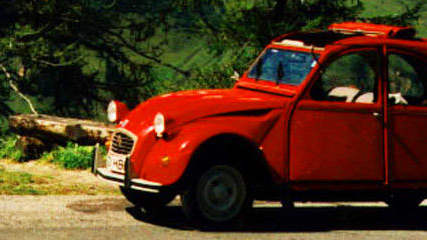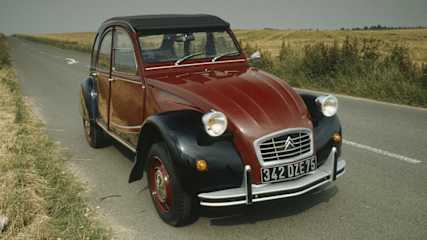1985 Citroen 2CV Reviews
You'll find all our 1985 Citroen 2CV reviews right here.
Our reviews offer detailed analysis of the 's features, design, practicality, fuel consumption, engine and transmission, safety, ownership and what it's like to drive.
The most recent reviews sit up the top of the page, but if you're looking for an older model year or shopping for a used car, scroll down to find Citroen 2CV dating back as far as 1985.

Used Citroen 2CV review: 1948-1990
Read the article
By Graham Smith · 22 Jun 2009
Britain had the Mini, Germany the Beetle, but France also had its iconic vehicle, the Citroen 2CV, and the ‘Tin Snail’ as it’s affectionately known has just turned 60. The 2CV is as recognizably French as the Eiffel Tower, the baguette and Moet champagne.Just like the Mini and the VW the 2CV was born to satisfy a need for small, economical and affordable transport. It not only was all of that, but it also went on to become a much-loved motoring icon much the same way the Mini and Beetle did. The 2CV perhaps isn’t as well known as the other two here as it wasn’t sold here in the same great numbers the other two were, but it has a strong following worldwide and a small, but loyal one here.MODEL WATCH The 2CV made its debut at the Paris Motor Show in 1948, but it was well underway before World War 2, the war merely delaying its introduction. When the idea for the 2CV was hatched motoring was still something only the well off could afford to indulge in. Car ownership hadn’t yet reached the masses, but there was a number of far-sighted motoring pioneers who realized there was money to be made if you could create a car the masses could afford.Henry Ford had his Model T, Herbert Austin his Seven, Hitler was mad keen to have a wagon for his people, and Citroen was hatching the 2CV. All had the same aim in mind. Their cars had to be light, easy to produce, economical and affordable.Citroen’s plan was to produce a car with four seats, a top speed of 50 km/h, one that would do 100 km on five litres of fuel, and would be cheap to produce and maintain. The 2CV was a reality in 1939, but the outbreak of war saw it put on the backburner as the French had more important things on their minds.It was finally launched in 1948. It was panned at first for its modest performance and poor finish, but that didn’t deter the French from buying it. So high was the demand that in no time at all there was a waiting list five years long.As Porsche had known when he was developing the Beetle for Hitler aerodynamics were important when you had a small motor, and so too did the 2CV’s designers who realized they had to have a shape that cut through the air efficiently. Hence, while the VW looked like a Beetle the Citroen had the shape of a snail. With its slab sides, rounded profile, canvas roof and flaps for windows who could not fall for the little Citroen.But there was much more to the 2CV than a cute shape. It had four-wheel long travel independent suspension, front-wheel drive, inboard brakes and a small air-cooled flat-twin cylinder motor. A clever system connected the front and rear suspension on each side and helped keep the little car level. It could indeed be driven over a ploughed field with a basket of eggs on the seat without breaking one of them, as the design brief had called for. It began with a tiny 375 cubic centimetre engine producing just nine kilowatts, but over the years grew to 652 cm3 and the performance increased in line with the increase in engine capacity.There have been many variations made on the 2CV theme, including vans, luxury models, some that even went faster than 100 km/h, and one even appeared in a James Bond movie. Ultimately the demands for cleaner engines and better safety caught up with the 2CV and spelt its demise. Production finally ceased in 1990, by which time more than five million had been built. Of that number a handful were imported and sold here in the 1950s, and one or two were imported in the 1980s. Most of the 300 or so that are thought to reside in this country have been privately imported by people who fell under the little car’s spell.IN THE SHOP The 2CV engines and gearboxes are quite reliable. The engine has a short crank thanks to its twin-cylinder boxer layout, and it runs in roller bearings so it will happily rev and run forever. Rust is the scourge of the 2CV, so look for it, particularly in the floor. Poor quality Russian steel was used through the 1970s and cars from that era tend to suffer more than most from the dreaded tin worm.While some parts are available here in Australia, there is a ready supply of parts from overseas suppliers, which are contactable through the Internet. Clubs are also a good source of info and parts. Go to www.citroenclassic.org.au for more info.IN A CRASH The need to build cars that were safe was one of the reasons the 2CV died; so don’t expect anything in the way of airbags or ABS braking in the little Citroen. It can be used for everyday transport if you’re well aware of its shortcomings, but perhaps it’s best left for a beaut drive on a sunny day when its more endearing features can be best enjoyed. There are few more frugal cars than the 2CV. Owners talk of five or so litres per 100 km, which are Toyota Prius hybrid numbers in today’s terms.OWNERS SAY Alison Harvey loves her 2CV Dolly, which she has owned for 15 years. It is her first car and she hopes it will be her last as there is nothing else like it. Alison brought it with her to Australia 10 years ago, primarily as an investment, but she knew she could never part with it. A flat battery poses no problem, she just gets out the crank handle and away she goes! Who needs air conditioning on a sunny day when you can just roll the roof back and have a stylish convertible? When she visits IKEA there is no need for a trailer or station wagon, she just takes out the seats and any size flatpack will fit. Similarly, on picnics she can take out the seats so there is no need to pack the camping chairs! It glides along on corrugated roads, leans around corners, gets up to a good speed and makes people smile wherever she goes.In 1976, while working and holidaying in Europe Don Scutt required an inexpensive mode of transport, so he bought a 2CV6. The 2CV covered 25,000 km carrying two adults, two children, luggage and camping gear and for some of the time a third adult. The car was, and still is comfortable, economical, fun to drive and a great way of meeting people, and as everyone knows fast, because on the road it is always at the head of a stream of (frustrated) traffic!LOOK FOR • Cute styling• Comfortable ride• Admiring looks• Reliable mechanics• Fun motoring• Body rustTHE BOTTOM LINE Great little fun car for an affordable entry into classic motoringRATING 85/100

Citroen 2CV French flair
Read the article
By Ashlee Pleffer · 04 Jan 2008
And the French really hit the nail on the head with the Citroen 2CV, and not just because of its unique looks. Drive it and you'll notice its individual behaviour as it leans into the corner as much as an Olympic speed skater.But for Rudi Annus, (above) his 1985 Citroen 2CV Charleston is the best way to travel.“I have always been attracted to Citroens,” he says. “I'm a car nut and I like anything that's different, I don't like ordinary standard BMWs or Mercs. It's just a funny little thing. It's almost that ugly, it's beautiful.”Annus used to envy Australian fashion designer Peter Weiss driving around his area in this black and burgundy 2CV and knew he had to have it. And after a year or so of pestering Weiss, he finally got to call it his own.“I have had it for about five years and paid $12,000 for it,” he says.The first Citroen 2CV was released in Europe in 1948 at the Paris motor show and quickly earned the nickname Deux Chevaux, French for two horses. Another nickname was Escargot (snail) as in, as slow as one.“The motor was only a 375cc and it only had two horsepower,” Annus says.And while most cars change over years, the Citroen didn't get big makeovers, apart from a few cosmetic changes in the 1960s and a slightly bigger engine capacity.“The engine got progressively bigger, to a 602cc engine, two cylinders,” he says.“That's what mine has. It's the biggest engine they ever built and it has a top speed of 115.2km/h. It drives quite good for a 602cc, it's amazing — that's a small motorbike.”The 2CV was originally conceived in the late 1930s as a cheap and economical car.“Above all it had to be able to cross a freshly ploughed field carrying two farmers, a sack of potatoes and a basket of a dozen eggs on the back seat, and not break any eggs,” Annus says.“It's incredible, such a basic and fundamental car. It has unique suspension, coil springs that are horizontal instead of up and down like normal cars.”And Annus's love affair with the 2CV isn't a new obsession. In 1994, Annus's son, who lives in the UK, was considering buying a 2CV for some fun. Annus said at the time: “If you don't buy it, I'll have it.”So, before he knew it he was pound stg. 400 ($908) poorer and the proud owner of his first 2CV, which he used regularly on European escapades. He then imported the model to Australia, where it now sits in “a million pieces” in his garage, waiting for a restoration. Something that may happen sooner than planned after Annus decided to sell this burgundy and black model.“If I didn't have the grey one, I wouldn't have sold this, I have to have a 2CV Citroen in my life,” he says. “These people approached me, they were at me for about a year-and-a-half, but I hadn't considered selling it at all.”Annus says he had always planned to restore the grey one and the new owners got him at a “weak moment”.“It's going to a good home,” he says. “I wouldn't sell it to just anybody who doesn't love Citroens and I'll use the money to restore the other one.” Annus sold the car for the same price he bought it for. He hasn't delivered it yet.So, in the meantime he's enjoying every minute and he's not the only one. Annus says the 2CV gets a big reaction from all onlookers.“I drove past a $400,000 Bentley, the guy smiled and gave me the thumbs up,” he says.And while Annus is also the proud owner of a 1990 Lotus Esprit he drove around Europe for a year before importing it Down Under, the 60-year-old says the Citroen is where he would rather spend his time.“I spend about 70 per cent of my time driving my little 2CV, people can't understand that.”Citroen stopped producing the 2CV in July 1990, after 42 years on the market and more than seven million cars.They were never officially sold in Australia, but they weren't strictly a French or European car, with some models built and sold elsewhere, including South America.SNAPSHOT1985 CITROEN 2CV CHARLESTONVALUE NOW: $10,000 to $18,000VERDICT: This quirky French-mobile knows how to put a smile on people's faces, with soft suspension, umbrella-like gear-stick and a two-cylinder engine.





